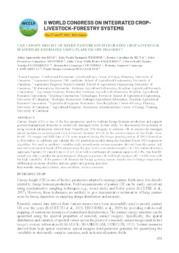Can canopy height of mixed pastures in integrated crop-livestock systems be estimated using planetscope imagery?
Can canopy height of mixed pastures in integrated crop-livestock systems be estimated using planetscope imagery?
Autoria: REIS, A. A. dos; WERNER, J. P. S.; SILVA, B. C. da; ANTUNES, J. F. G.; ESQUERDO, J. C. D. M.; FIGUEIREDO, G. K. D. A.; COUTINHO, A. C.; LAMPARELLI, R. A. C.; MAGALHÃES, P. S. G.
Resumo: ABSTRACT. Canopy height (CH) is one of the key parameters used to evaluate forage biomass production and support grazing management decisions in intensively managed fields. In this study, we demonstrate the potential of using textural information derived from PlanetScope (PS) imagery to estimate CH of intensively managed mixed pastures in an Integrated Crop-Livestock Systems (ICLS) in the western region of São Paulo State, Brazil. PS images and field data of CH were acquired during the forage growing season of 2019 (from May to November) to calibrate and validate the CH prediction models using the Random Forest (RF) regression algorithm. We used as predictor variables eight second-order texture measures derived from the green, red, near-infrared spectral bands of PS images using the grey level co-occurrence matrix (GLCM) statistical texture approach. Pasture CH varied from 0.12 to 1.20 m with a coefficient of variation equal to 63.34%. Our best RF model was able to predict the spatiotemporal changes in pasture CH with high accuracy (R2 = 0.88) even with the high variability of the pasture CH through the forage growing season, mainly due to forage composition (different proportions of millet and ruzi grass) and grazing activities.
Ano de publicação: 2021
Tipo de publicação: Artigo em anais e proceedings
Unidade: Embrapa Agricultura Digital
Observações
1 - Por padrão são exibidas publicações dos últimos 20 anos. Para encontrar publicações mais antigas, configure o filtro ano de publicação, colocando o ano a partir do qual você deseja encontrar publicações. O filtro está na coluna da esquerda na busca acima.
2 - Para ler algumas publicações da Embrapa (apenas as que estão em formato ePub), é necessário ter, no celular ou computador, um desses softwares gratuitos. Sistemas Android: Google Play Livros; IOS: iBooks; Windows e Linux: software Calibre.
Acesse outras publicações
Acesse a Base de Dados da Pesquisa Agropecuária (BDPA) para consultar o acervo completo das bibliotecas da Embrapa.

